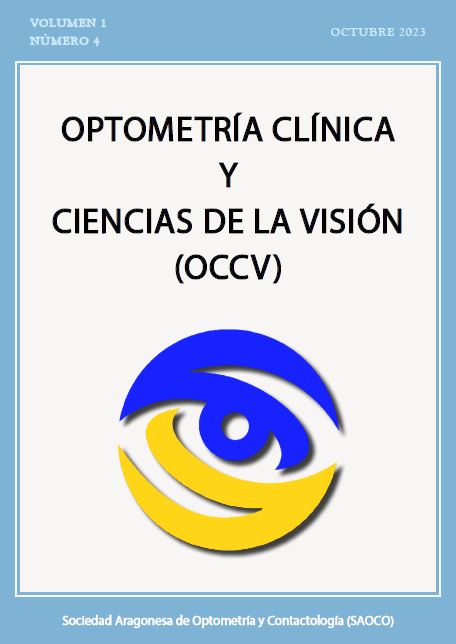Myopia control today. Most used treatments.
Main Article Content
Abstract
Relevance: The purpose of this work is to identify treatments that provide the greatest benefits in myopia control, with the aim of preventing risk factors in the future, avoiding severe vision loss, and improving the patient's visual quality.
Summary: The objective of this work is to conduct a literature review on different types of myopia control methods to determine the most commonly used and effective approach to date. Additionally, it will review both the basic concepts of myopia and the risk factors associated with its progression. A literature search was conducted in the PubMed database, optometric books, and the optometric and ophthalmic gazette of the College of Optometrists from articles published since 2000, selected based on inclusion and exclusion criteria. A total of 4939 results were found for the main objective of the work, which were narrowed down using inclusion and exclusion criteria to obtain a total of 30 articles divided into the introduction and discussion sections of the paper. Currently, treatments with significant efficacy are atropine and orthokeratology. However, there are new advancements such as peripheral defocus contact lenses that demonstrate improvements in the side effects of these two former treatments. Despite significant progress and the emergence of new treatments, further research on myopia control is necessary.
Article Details

This work is licensed under a Creative Commons Attribution-NonCommercial 4.0 International License.
How to Cite
References
Montes,R. Optometría.Principios básicos y aplicación clínica. España: Elseiver; 2011. 5p.
Carr BJ, Stell WK. The Science Behind Myopia. In: Kolb H, Fernandez E, Nelson R, eds. Webvision: The Organization of the Retina and Visual System. Salt Lake City (UT): University of Utah Health Sciences Center; November 7, 2017.
Holden BA, Fricke TR, Wilson DA, et al. Global Prevalence of Myopia and High Myopia and Temporal Trends from 2000 through 2050. Ophthalmology. 2016;123(5):1036-1042. doi:10.1016/j.ophtha.2016.01.006
Wu PC, Huang HM, Yu HJ, Fang PC, Chen CT. Epidemiology of Myopia. Asia Pac J Ophthalmol (Phila). 2016;5(6):386-393. doi:10.1097/APO.0000000000000236
Hageman GS, Gehrs K, Johnson LV, Anderson D. Age-Related Macular Degeneration (AMD). In: Kolb H, Fernandez E, Nelson R, eds. Webvision: The Organization of the Retina and Visual System. Salt Lake City (UT): University of Utah Health Sciences Center; January 1, 2008.
Blair K, Czyz CN. Retinal Detachment. In: StatPearls. Treasure Island (FL): StatPearlsPublishing; December 26, 2022.
Nizami AA, Gulani AC. Cataract. In: StatPearls. Treasure Island (FL): StatPearlsPublishing; July 5, 2022.
Kolb H, Fernandez E, Nelson R, eds. Webvision: The Organization of the Retina and Visual System. Salt Lake City (UT): University of Utah Health Sciences Center; 1995.
Jonas JB, Ang M, Cho P, et al. IMI Prevention of Myopia and Its Progression. InvestOphthalmol Vis Sci. 2021;62(5):6. doi:10.1167/iovs.62.5.6
Tran HDM, Tran YH, Tran TD, Jong M, Coroneo M, Sankaridurg P. A Review of Myopia Control with Atropine. J Ocul Pharmacol Ther. 2018;34(5):374-379. doi:10.1089/jop.2017.0144
Singh K, Bhattacharyya M, Goel A, Arora R, Gotmare N, Aggarwal H. Orthokeratology in Moderate Myopia: A Study of Predictability and Safety. J Ophthalmic Vis Res. 2020;15(2):210-217. Published 2020 Apr 6. doi:10.18502/jovr.v15i2.6739
Hiraoka T. Myopia Control With Orthokeratology: A Review. Eye Contact Lens. 2022;48(3):100-104. doi:10.1097/ICL.0000000000000867
Sankaridurg P. Contact lenses to slow progression of myopia. Clin Exp Optom. 2017;100(5):432-437. doi:10.1111/cxo.12584
Jiang X, Kurihara T, Torii H, Tsubota K. Progress and Control of Myopia by Light Environments. Eye Contact Lens. 2018;44(5):273-278. doi:10.1097/ICL.0000000000000548
Chen J, Zhuo R, Chen J, et al. Spectacle lenses with slightly aspherical lenslets for myopia control: clinical trial design and baseline data. BMC Ophthalmol. 2022;22(1):345. Published 2022 Aug 16. doi:10.1186/s12886-022-02562-0
Lam CS, Tang WC, Lee PH, et al. Myopia control effect of defocus incorporated multiple segments (DIMS) spectacle lens in Chinese children: results of a 3-year follow-up study. Br J Ophthalmol. 2022;106(8):1110-1114. doi:10.1136/bjophthalmol-2020-317664
Ochoa-Sangrador C. Evidencia y recomendación. ORL [Internet]. 9 de marzo de 2016 [citado 2 de Febrero de 2023];7(2):67-71. Disponible en: https://revistas.usal.es/cinco/index.php/2444-7986/article/view/orl201672.14019
Haynes RB. Of studies, syntheses, synopses, and systems: the "4S" evolution of services for finding current best evidence. ACP J Club. 2001;134(2):A11-A13.
Dicenso A, Bayley L, Haynes RB. Accessing pre-appraised evidence: fine-tuning the 5S model into a 6S model. Evid Based Nurs. 2009;12(4):99-101. doi:10.1136/ebn.12.4.99-b
Bullimore MA, Ritchey ER, Shah S, Leveziel N, Bourne RRA, Flitcroft DI. The Risks and Benefits of Myopia Control. Ophthalmology. 2021;128(11):1561-1579. doi:10.1016/j.ophtha.2021.04.032
Jiang X, Kurihara T, Torii H, Tsubota K. Progress and Control of Myopia by Light Environments. Eye Contact Lens. 2018;44(5):273-278. doi:10.1097/ICL.0000000000000548
Ha A, Kim SJ, Shim SR, Kim YK, Jung JH. Efficacy and Safety of 8 Atropine Concentrations for Myopia Control in Children: A Network Meta-Analysis. Ophthalmology. 2022;129(3):322-333. doi:10.1016/j.ophtha.2021.10.016
Upadhyay A, Beuerman RW. Biological Mechanisms of Atropine Control of Myopia. Eye Contact Lens. 2020;46(3):129-135. doi:10.1097/ICL.0000000000000677
Santodomingo-Rubido J, Villa-Collar C, Gilmartin B, Gutiérrez-Ortega R. Myopia control with orthokeratology contact lenses in Spain: refractive and biometric changes. Invest Ophthalmol Vis Sci. 2012;53(8):5060-5065. Published 2012 Jul 31. doi:10.1167/iovs.11-8005
Cho P, Cheung SW, Edwards M. The longitudinal orthokeratology research in children (LORIC) in Hong Kong: a pilot study on refractive changes and myopic control. Curr Eye Res. 2005;30(1):71-80. doi:10.1080/02713680590907256
Tan Q, Ng AL, Cheng GP, Woo VC, Cho P. Combined Atropine with Orthokeratologyfor Myopia Control: Study Design and Preliminary Results. Curr Eye Res. 2019;44(6):671-678. doi:10.1080/02713683.2019.1568501
Sánchez-González JM, De-Hita-Cantalejo C, Baustita-Llamas MJ, Sánchez-González MC, Capote-Puente R. The Combined Effect of Low-dose Atropine with Orthokeratology in Pediatric Myopia Control: Review of the Current Treatment Status for Myopia. J Clin Med. 2020;9(8):2371. Published 2020 Jul 24. doi:10.3390/jcm9082371
Gao Y, Lim EW, Yang A, Drobe B, Bullimore MA. The impact of spectacle lenses for myopia control on visual functions. Ophthalmic Physiol Opt. 2021;41(6):1320-1331. doi:10.1111/opo.12878
Ma JX, Tian SW, Liu QP. Effectiveness of peripheral defocus spectacle lenses in myopia control: a Meta-analysis and systematic review. Int J Ophthalmol. 2022;15(10):1699-1706. Published 2022 Oct 18. doi:10.18240/ijo.2022.10.20
Ruiz-Pomeda A, Pérez-Sánchez B, Valls I, Prieto-Garrido FL, Gutiérrez-Ortega R, Villa-Collar C. MiSight Assessment Study Spain (MASS). A 2-year randomized clinical trial. Graefes Arch Clin Exp Ophthalmol. 2018;256(5):1011-1021. doi:10.1007/s00417-018-3906-z

